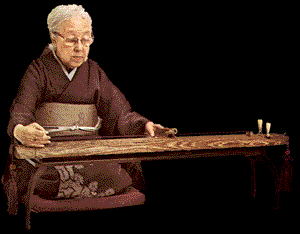 |
 |
| Nigenkin The Azuma nigenkin, often just referred to as the nigenkin, is an extremely rare two-string zither found only in the Asakusa suburb of Tokyo. The nigenkin is a fairly recent instrument adapted from the Yakumo-goto, a two-string zither used exclusively in Shinto shrines. In the early Meiji Period (1868-1912), Tosha Rosen, a Yakumo-goto player, started to use the instrument to perform the secular popular music of the time (hauta and zokkyoku), and as a result was asked to sever his association with the Shinto Shrine and was forbidden to play the Yakumo-goto. He therefore created the Azuma nigenkin, with only subtle differences to its predecessor, notably an open back and less ornamentation.  The name Tosha Rosen was then passed through the family, eventually from mother to daughter, as each took on the title of Iemoto of the Azuma nigenkin, but the last Tosha Rosen died in 2004 without naming a successor. She had only 25 students. The fate of this instrumental style is unknown. There are only two known players of the nigenkin outside of Japan, and only Randy Raine-Reusch performs on this instrument regularly. The name Tosha Rosen was then passed through the family, eventually from mother to daughter, as each took on the title of Iemoto of the Azuma nigenkin, but the last Tosha Rosen died in 2004 without naming a successor. She had only 25 students. The fate of this instrumental style is unknown. There are only two known players of the nigenkin outside of Japan, and only Randy Raine-Reusch performs on this instrument regularly. The nigenkin is played with a plastic or ivory pick and a large slide called a rokan. The rokan is slid along the strings, which are tuned in unison, to the desired pitch. As the nigenkin has two bridges on either end of the instrument, the strings on both sides of the rokan sound when it is moved, producing a ghost like secondary tone, which is quite beautiful. There are 95 original works for Azuma nigenkin mostly composed by the original Tosha Rosen, but the repertoire also includes popular songs from its inception to present. Randy Raine-Reusch has also added works to its repertoire. Country: Japan |
|
 |
|
| © R. Raine-Reusch, May 2002 |